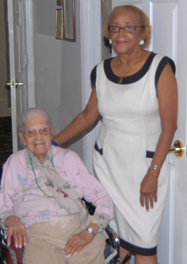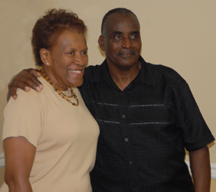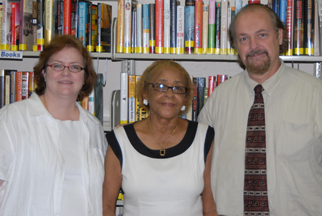

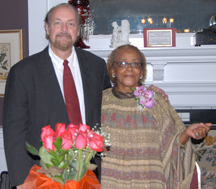 with N. Carolyn Thompson at the Staley High School Reunion Banquet |
Curator’s Statement |
||||||||||||||||||
| I have many wonderful thoughts and feelings about my visit to Americus in 2007. Carolyn Thompson displayed her thoroughness, attention to detail, graciousness, and kindness long before my arrival, even as she was in the midst of organizing and arranging a massive high school reunion for all of the Staley classes. | |||||||||||||||||||
|
|||||||||||||||||||
Despite her countless details and last moment organizational issues, she set aside time to take me to Plains to meet with Dorothy Apple, an afternoon that I will never forget for so many reasons. That, along with Carolyn’s many other gestures, essays, and research notes through the years, has permitted me to designate her as an assistant director for this entire study. Her organizational abilities match any CEO and her research insights match any university historian. |
|||||||||||||||||||
During my visit and attendance at the reunion, I had many fantastic and unexpected moments—learning that Minnie D. Haynes was good friends with my colleague (and hero), Cleveland Sellers; discovering a mutual love for the trombone with Robert Hollis (and having the opportunity to hear him and Ray Daniels perform); chatting about the significance of history with many individuals including Morris Dozier; becoming teary-eyed as I sat in the presence of so many distinguished classroom teachers—Vernelle Harris Hall, Ernestine V. Moore, Addie Rose Owens, to name just a few—whose efforts and struggles truly changed the lives of so many students. And while I had assumed my “research” was completed, I have continued to work on the Staley exhibition during the past few years, allowing me, thank goodness, to receive one of the greatest gifts—the opportunity to visit Alpha Hines Westbrook in the spring of 2011 at her Augusta home. Being in the presence of this remarkable woman reminded me of the importance of this project and how so many local heroes and heroines of the civil rights era need to be featured. |
|||||||||||||||||||
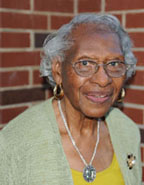 Alpha Hines Westbrook |
|
||||||||||||||||||
Through the flurry of activities and events during the weekend reunion, George Glover provided me with a safe haven—an area to stand when I felt out of place, and a welcoming glance and a smile when I wondered what I should do next. Much can be learned merely by standing next to another person—especially George—and he introduced me to the area’s cuisine and dialect, both topics proving wonderfully interesting.
|
|||||||||||||||||||
|
|||||||||||||||||||
As one of the first site visits, the research aspect of this entire project developed its soul in Americus. I arrived as a researcher and left as a learner who was so appreciative of the kindness and graciousness of all of my many teachers—Staley High School educators and students who attended the reunion—I met during my visit. I learned much more than mere details about this wonderful and remarkable school. I realized that kind, gracious individuals would overlook my gaffes. And I realized that I should know the second verse of Lift Every Voice and Sing and not hum a few phrases. From that moment onward, I always thought of Staley when, at other school sites, I would confidently (and quietly) sing a song that all Americans should know by heart. My visit to Americus taught me that a sense of community never dies and, when high school friends come together to talk about their experiences, I should allow the strength of camaraderie to come forth. I quickly realized that our oral history conversations would be determined not by my predefined questions but, rather by those individuals in the room. I would later be surprised by the degree of candidness that would occur in subsequent interviews at other school sites, but Americus will always stand as a testimony to the power of the group and the willingness of school friends, when sitting together, to discuss topics that I thought would be taboo: street racism, lynching, meanness rooted in the most benign gestures. I only hope that this web exhibition about Staley High School can convey the significance of this school—for Georgia and for the Southeast—and, perhaps more importantly, to the educational leaders and citizens of Americus. Craig Kridel |
|||||||||||||||||||

an institutional member of the International Coalition of Sites of Conscience
curator@museumofeducation.info

